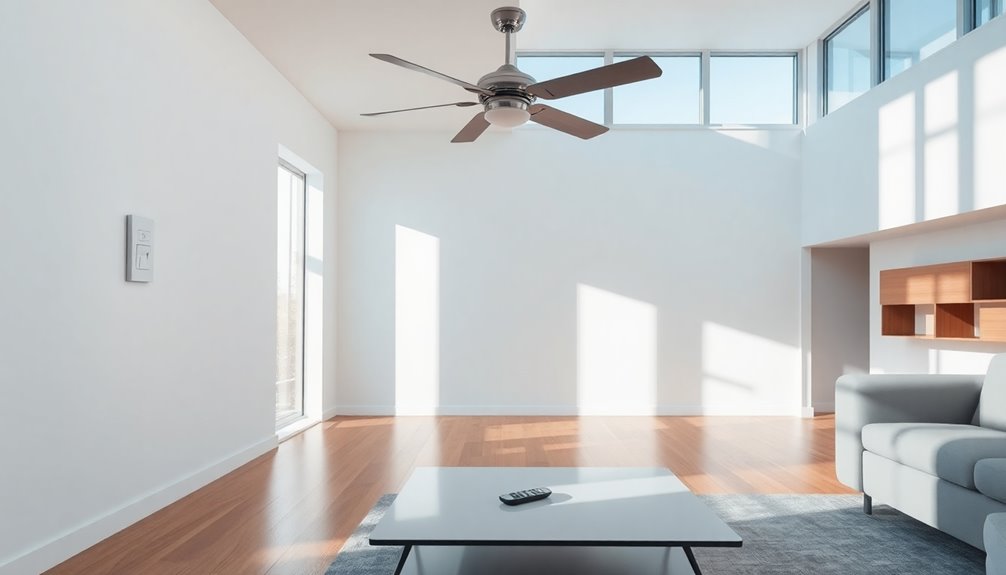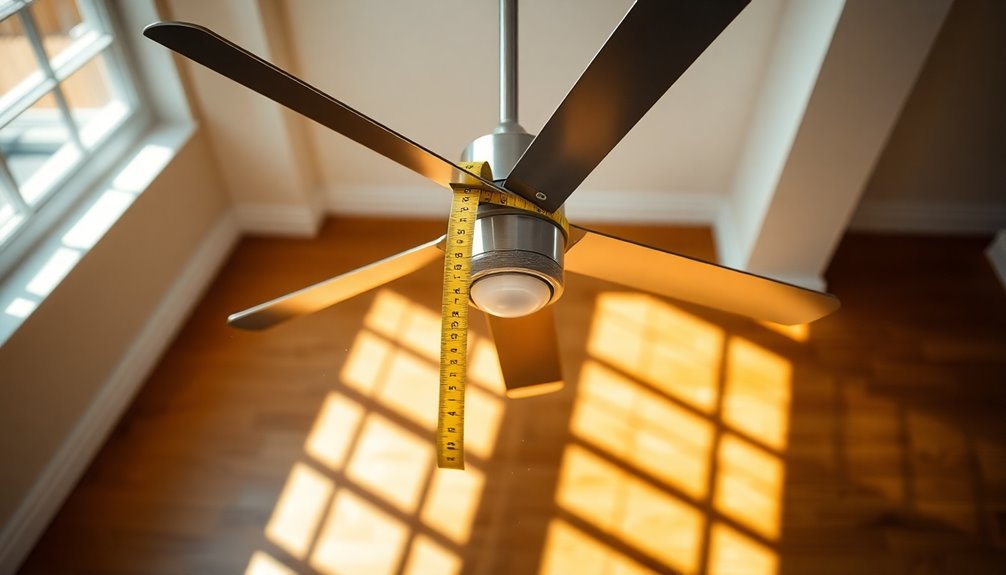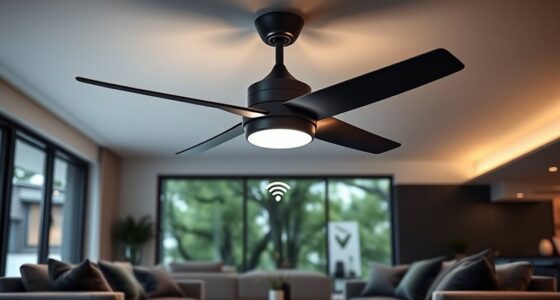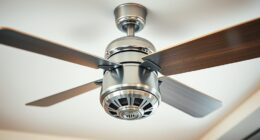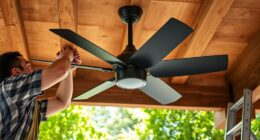Ceiling fans do work by creating airflow that enhances your comfort through the wind chill effect, rather than actually lowering the room's temperature. When used in summer, setting the fan to rotate counter-clockwise helps cool you down, while reversing it in winter can distribute warm air effectively. They're energy efficient too—consuming about 1% of the energy used by traditional air conditioners—allowing you to raise your thermostat setting without sacrificing comfort. So, you not only save energy but also improve your room's ambiance. Curious about the best installation tips and ideal fan sizes for your space?
Key Takeaways
- Ceiling fans create airflow, enhancing cooling sensation through the wind chill effect, but do not lower room temperature.
- They can improve comfort by making the room feel 4-5°F cooler, allowing higher thermostat settings in summer.
- Operating a ceiling fan uses significantly less energy than air conditioning, making it a cost-effective alternative.
- Fans can be set to reverse direction in winter, helping to distribute warm air effectively throughout the room.
- Proper installation and maintenance are crucial for optimal performance and safety of ceiling fans.
Understanding Ceiling Fan Functionality

Ceiling fans are designed to create airflow through rotating blades, generating a breeze that enhances your cooling sensation. They don't actually lower room temperature, but instead utilize the wind chill effect to make you feel cooler.
By promoting air movement, ceiling fans can complement your air conditioning, allowing you to raise your thermostat setting in warmer months. This adjustment can lead to significant energy savings, as you'll rely less on your HVAC system.
In summer, set your ceiling fan to rotate counter-clockwise for ideal downward airflow, which maximizes cooling capabilities.
In winter, reversing the direction helps distribute warm air, making your home feel cozy without cranking up the heat.
Proper usage also plays an essential role in efficient cooling; remember to turn off the fan when the room is unoccupied to conserve energy.
Benefits of Using Ceiling Fans

When it comes to staying comfortable in your home, ceiling fans offer a range of benefits that can enhance your living environment. First, they can lower your ambient temperature perception by 4-5 degrees Fahrenheit, making you feel cooler without actually cooling the air. This means you can raise your thermostat settings by up to 4°F in the summer, reducing your air conditioning usage and ultimately leading to lower energy bills.
Ceiling fans are also incredibly energy-efficient, consuming only about 1% of the energy used by traditional air conditioners. This makes them a cost-effective alternative for improving air circulation in your home.
Additionally, during winter months, you can operate your ceiling fan on low speed to reverse blade direction, helping distribute warm air that rises, thereby creating a more comfortable atmosphere.
Many ceiling fans come with built-in lighting, providing dual functionality that not only enhances the room's illumination but can also increase your home's value.
With these benefits, integrating ceiling fans into your living space is a smart choice for comfort and efficiency.
Energy Efficiency Considerations

When you're looking to cut down on energy costs, ceiling fans can be a game changer.
By allowing you to raise your thermostat in the summer without sacrificing comfort, you can save considerably on cooling bills.
Plus, opting for Energy Star certified fans boosts efficiency even more, putting money back in your pocket.
Cost Savings Potential
For those looking to save on energy costs, ceiling fans offer a smart and efficient alternative to traditional air conditioning. By using ceiling fans, you can reduce reliance on your AC unit, allowing you to raise your thermostat settings by up to 4°F without sacrificing comfort. This simple adjustment can lead to significant energy savings, ultimately lowering your energy bills.
Operating a ceiling fan consumes about 1% of the energy used by air conditioners, which makes it a cost-effective cooling solution. In fact, running a ceiling fan for 24 hours uses less energy than just 15 minutes of air conditioning. That's impressive!
If you opt for Energy Star certified ceiling fans, you'll benefit even more, as these models are up to 60% more efficient than conventional ones. This efficiency not only saves you money on monthly bills but can also extend the lifespan of your HVAC system by decreasing how frequently it needs to cycle on and off.
Energy Star Benefits
Choosing an ENERGY STAR® certified ceiling fan not only amplifies the cost savings potential but also enhances energy efficiency in your home. These fans are up to 40% more efficient than conventional models, translating to substantial energy savings. They consume about 1% of the energy used by air conditioners, making them a cost-effective cooling solution.
By operating an ENERGY STAR® fan, you can comfortably raise your thermostat settings by 4°F in summer without sacrificing comfort. Additionally, fans featuring DC motors, common in Energy Star models, use up to 70% less energy than traditional AC motors. This means you can enjoy your living space while being eco-conscious.
Here's a quick comparison of the benefits of ENERGY STAR ceiling fans:
| Benefits | ENERGY STAR® Certified | Conventional Fans |
|---|---|---|
| Energy Efficiency | Up to 40% more | Standard efficiency |
| Energy Consumption | 1% of AC usage | Higher energy usage |
| Thermostat Adjustment | +4°F without discomfort | Limited adjustment |
| Motor Type | DC motors | AC motors |
| Cost Savings Potential | Significant | Limited savings |
Investing in an energy-efficient ceiling fan is a smart choice for your wallet and the planet.
Installation and Design Guidelines

When installing your ceiling fan, it's essential to get the height right—aim for 7-9 feet above the floor to promote effective air circulation.
You'll also want to take into account the size of your room; larger spaces may need multiple fans for ideal comfort.
Finally, don't forget about aesthetics; select a fan that fits the scale of your room to enhance its overall look.
Ideal Fan Height
The ideal height for your ceiling fan plays an essential role in ensuring effective air circulation and safety in your space. To achieve peak airflow, install your ceiling fans with the fan blades positioned 7-9 feet above the floor. This height allows for adequate airflow without compromising safety.
Additionally, maintain a clearance of 10-12 inches between the fan blades and the ceiling. This distance enhances airflow efficiency and prevents obstruction.
It's also important to take into account the surrounding space. Keep at least 18 inches of space between the fan and walls to avoid air blockage, ensuring effective circulation throughout the room. If your room measures longer than 18 feet, you might need multiple fans to provide adequate airflow and comfort across the entire area.
Don't forget about aesthetics. Larger ceiling fans can overpower smaller rooms, so select a fan size and design that complements your decor while maintaining the necessary functionality.
Room Size Considerations
Understanding room size is essential for selecting and installing a ceiling fan that maximizes comfort and efficiency. The right ceiling fan can greatly enhance air circulation, making your space feel cooler and more inviting.
- Consider the fan's diameter for effective cooling.
- Guarantee proper clearance between fan blades and ceiling or walls.
- Think about installing multiple fans in larger rooms.
For ideal airflow, install your fan with blades positioned 7-9 feet above the floor, keeping them 10-12 inches away from the ceiling and at least 18 inches from walls. This setup allows air to move freely, enhancing air circulation throughout the room.
If you're dealing with larger rooms over 18 feet, it's recommended to use multiple fans to maintain a comfortable environment.
When selecting a fan, remember that those with a diameter of 36-44 inches are ideal for spaces up to 225 square feet. Larger fans are suitable for bigger areas but can overpower smaller rooms.
Choosing the right size and placement of ceiling fans guarantees you get the most out of their cooling capabilities while maintaining a balanced look in your space.
Aesthetic Design Choices
Choosing the right ceiling fan isn't just about functionality; it also plays an essential role in your room's aesthetic. You want a fan that complements your space while guaranteeing ideal airflow. When making design choices, consider fan sizes that align with your room dimensions. Oversized fans in small rooms can dominate the decor, while tiny fans in larger spaces may look out of place.
Here's a quick guide to help you choose the right fan based on room size:
| Room Size (sq ft) | Recommended Fan Size | Aesthetic Considerations |
|---|---|---|
| Up to 225 | 36-44 inches | Sleek and proportional |
| 225-400 | 44-54 inches | Balanced and functional |
| 400-800 | 54-60 inches | Bold statement pieces |
| 800+ | 60+ inches | Multiple fans for flow |
For installation, keep blades 7-9 feet above the floor and 10-12 inches from the ceiling. Guarantee at least 18 inches from walls for proper air circulation. With the right ceiling fan, you can enhance both comfort and style in your home.
Common Misconceptions About Ceiling Fans

Ceiling fans often get a bad rap due to several misconceptions that can lead to inefficient use and misunderstanding of their benefits. Here are some common myths you might've encountered:
- Ceiling fans actually lower room temperature.
- They're only useful during the summer months.
- All ceiling fans are equally energy efficient.
In reality, ceiling fans don't lower the room temperature; they create airflow that enhances the cooling sensation, making you feel cooler.
And while many people think they're just for summer, you can reverse the direction of your ceiling fan to circulate warm air in winter, which helps improve heating efficiency.
When it comes to energy efficiency, not all ceiling fans are created equal. Look for ENERGY STAR® certified models, which can be up to 60% more efficient than traditional fans.
Lastly, if you believe ceiling fans are noisy, think again. Higher-quality fans operate quietly and smoothly, allowing you to enjoy comfort without disruptive noise. Commercial grade heat pumps can also complement ceiling fans by enhancing overall climate control in larger spaces.
Understanding these misconceptions can help you maximize the benefits of your ceiling fans, whether you're in a small room or larger spaces.
Maintenance and Care Tips

Maintaining your ceiling fan is essential to keeping it running smoothly and efficiently. By following a few simple maintenance tips, you can enhance its performance and prolong its lifespan.
| Task | Frequency |
|---|---|
| Clean fan blades | Monthly |
| Tighten screws | Every 6 months |
| Conduct electrical checks | Every year |
| Replace light bulbs | As needed |
| Check installation | Annually |
Regularly cleaning the fan blades is vital to remove dust accumulation that can hinder efficiency and affect aesthetics. Make certain to tighten screws and connections every six months to prevent noise and wobbling. Conduct electrical checks annually to verify the motor functions properly and to avoid safety hazards.
When replacing light bulbs, consider using energy-efficient options to enhance lighting effectiveness while reducing energy consumption. Finally, confirm that your fan is securely installed and balanced to prevent accidents and guarantee peak operation. By following these maintenance tips, you'll keep your ceiling fan in top shape and enjoy a comfortable environment.
Frequently Asked Questions
Do Ceiling Fans Really Cool a Room?
When you ask if ceiling fans really cool a room, it's important to know that they don't lower the temperature.
Instead, they create airflow that makes you feel cooler through the wind chill effect. By circulating air, you can raise your thermostat settings while still staying comfortable.
To maximize their cooling potential, make sure to set your fan to rotate counter-clockwise in summer, directing airflow downward for that invigorating breeze.
Are Ceiling Fans Actually Useful?
Ceiling fans are definitely useful! They create a cooling breeze that makes you feel more comfortable, allowing you to raise your thermostat settings in summer and save on energy costs.
Plus, they use just a fraction of the energy that air conditioners do. If you properly install and maintain them, they can improve air circulation and help your HVAC system last longer.
What Are the Disadvantages of Ceiling Fans?
When you think about ceiling fans, it's easy to picture a scene from a classic movie, where they slowly rotate in the background.
But there are disadvantages to evaluate. Their built-in lights often lack power for larger rooms, they can create noise over time, and cleaning them can be a hassle.
Plus, their aesthetic might clash with your decor, and low ceilings can pose injury risks for taller folks.
Do Ceiling Fans Make a Big Difference?
Yes, ceiling fans can make a big difference in your comfort level.
By creating a cooling breeze, they can help you feel cooler, allowing you to set your thermostat a bit higher.
When you use them properly, they can enhance air circulation and reduce your reliance on air conditioning.
This not only keeps your space comfortable but also saves you money on energy bills.
Conclusion
To sum up, ceiling fans aren't just simple appliances; they're your room's personal air wizards! With a flick of a switch, they can transform a sweltering sauna into a breezy oasis faster than you can say "cool breeze." By understanding their power, you'll not only stay comfortable but also save a fortune on energy bills. So go ahead, embrace the magic of ceiling fans and let them dance through your space, turning your home into a revitalizing paradise!

